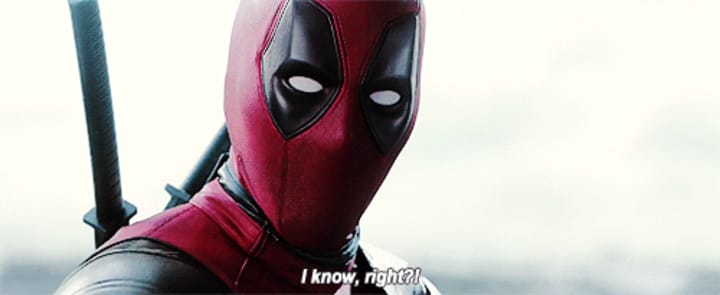‘Deadpool 2’ and Why It Feels so Familiar
The Merc With the Mouth is back, but he’s not packing as much of a punch this time.

Deadpool 2 is out and it is already receiving mixed reactions. The first film was a surprise runaway success, but that’s because the film was highly anticipated and, for the most part, director Tim Miller and his team of writers, Rhett Reese and Paul Wernick, understood the pulse of the character and his fans.
Deadpool 2, on the other hand, is an uneven follow-up that ticks all the requisite boxes of a sequel yet never quite feels as authentic or organic as its predecessor. We could put this down to a change in director and perhaps the imposition of star Ryan Reynolds (credited as a writer on this film)—apparently creative differences between Reynolds and Miller led to the latter’s departure.
The USP of Deadpool, either in comics, games, or on screen, is to break the fourth wall and make fun of everything. Nothing escapes the clutches of the "merc with the mouth," and that’s mostly why we love him. Where Deadpool 2 often fails is when it leans too heavily on the novelty that is Deadpool and his R-rated shenanigans, rather than being a wholesome new experience for the viewer. The film is mostly a hysterical romp with Easter eggs, a host of comic book favourites and pop culture puns aplenty. What it needed was tighter, better writing and an even pace. The final product by director David Leitch feels like a sports car with a sticky brake—coming to a stop at all the wrong times and speeding up just when the scenery looks pretty.

Thanos, I mean Cable, demands your silence (Credit: 20th Century Fox)
Much of the film’s plot feels all-too familiar. When, at one point, Domino exclaims Deadpool’s team name seems a little derivative, one wonders if the joke is on her or the audience. Hidden just under the surface of the pervasive violence and cursing is a narrative structure we have met before and should not be revisiting in a film that touts itself as being "different." Spoilers ahead, so head to your nearest cinema before reading.
1. Fridging Season

Vanessa (Credit: 20th Century Fox)
The film begins in medias res, in keeping with its predecessor, before an over-the-top opening credit scene hints at key plot points of the film. Yes, the stylized, James Bond-esque credits were a joy to behold despite it being made with tongue firmly in cheek. What it doesn’t hide is that, yet again, a superhero film fridged its main female love interest in lieu of plot development for the male character. Morena Baccarin’s Vanessa is a "hero" in her own right in the comics, but in the Deadpool films, she has been reduced to a damsel-in-distress/love interest. Her main arc in Deadpool 2 is to be excited about having a baby and then promptly dying before Wade Wilson gets to enjoy fatherhood. After that, she’s a dream sequence. No wonder Baccarin spends so much time in Gotham instead.
Ness isn’t the only woman to get fridged, either. Cable (Josh Brolin’s other comic book appearance this year), starts off his journey next to the ashes of his wife and daughter. Yet again, the death of women propels a male character to action and to exact revenge. Even if these storylines are part of comic history, one has to question how they are relevant in 2018. Almost anything could be the catalyst for a hero to act, but no, Reese and Wernick went with the tried and wasted.
2. Déjà Vu

Walking a familiar path. Still from X-Men: Days of Future Past. (Credit: 20th Century Fox)
Following Ness’ death, Deadpool hits rock bottom, ends up in the X-Mansion and becomes a trainee X-Man, only for his first mission to end with him being arrested along with angry, young mutant Firefist/Russell (Julian Dennison). Russell tries to befriend Wade while they’re in the Icebox (a mutant prison) but fails miserably. Many prison jokes ensue (at the cost of a 14-year-old boy) before Cable breaks in. His mission: kill Russell before Russell grows up to kill his family. And, so begins a well-trodden plotline that we have seen re-enacted countless times, not least in the cinematic X-Men universe itself.
If you recall X-Men: Days of Future Past (the 2014 film, and to some extent, the comic), Charles Xavier and Magneto send Wolverine back in time to stop Mystique from becoming a killer. One death eventually leads to another, which paves the way for the frightening future we see in the opening sequence of the film. In the comic book, Mystique was already a villain; her assassination of Senator Robert Kelly rallies the frightened humans to activate the Sentinel programme. Much of the film was about saving Mystique from becoming a villain. Russell’s story follows a similar path.
The plotline of Deadpool 2 feels so familiar because it is—the comic book character ‘Rusty’ (as he’s referred to on-page) has a disturbing start to his career, one which he spends a great deal of time making amends for. I’m glad the film-makers changed up the all-American look for a plus-size character who talks about industry bias, but Russell’s story is still too similar to Mystique’s in DOFP to be refreshing.
3. Dream a Little Dream

The Astral Plane in X-Men: Apocalypse (Credit: 20th Century Fox)
Then there are the "dream sequences." We see them several times during the course of this film—could they be Wade’s astral projections? He’s not known for his telepathy, as far as I recall, but when he’s fiddling with Cerebro, it is implied that he is actually using it. So, perhaps, he is in the astral plane speaking to the memories of his dead girlfriend, or his brain is creating these visions near death. Whatever the case, they are an old-fashioned inclusion in a film that is supposed to cater to modern audiences. Sequences like these always put the brakes on the plot and act as little more than glamourous exposition. That is why it is a tired cliché that went out with the 90s. Or so we thought.
There is something especially Harry Potter-esque to his final dream. Following an overlong death scene (it was funny for about two minutes), Wade is back in the dream-world listening to Ness tell him this isn’t his time. The interaction borders on the kind of writing we are used to from Lifetime movies. Also, we had a similar dream sequence in Avengers: Infinity War just last month, and it is reminiscent of Harry Potter’s near-death in the final book/film, when he has a "dream" where Dumbledore says to him, "Of course it is happening inside your head, Harry, but why on earth should that mean that it is not real?" Yes, one self-aware dream sequence a decade is all we need. Twice in a year makes me wonder if Hollywood’s writers have become lazy or just couldn’t be bothered anymore.
4. The Woke is not enough.

'X-Force' (Credit: 20th Century Fox)
Deadpool felt like a breath of fresh air in 2016, because it didn’t take itself too seriously, yet went the extra mile to please fans and attract a vast audience. Yes, in the end, the film dwindled down to being a heteronormative love story, but not without plenty of gore and swearing thrown in prior to that. As with all sequels, we hoped for much more.
For one, Deadpool’s pansexual identity was completely erased in the first film. It’s back with a bang in this one, but the creators do not push the envelope far enough. Deadpool flirts with Colossus non-stop, and shares bawdy jokes with Cable, and that’s a big step forward. We also, finally, have an out Lesbian couple in a superhero studio film, Negasonic Teenage Warhead (Brianna Hildebrand) introduces us to her girlfriend, the eminently likeable Yukio (Shioli Kutsuna), and they are inseparable throughout. Baby steps!
Aside from that, however, the writers only pay lip service to representation. Just enough to appear "woke." Deadpool mistakes Cable for a bigot because he kills Black Tom Cassidy, a white character in dreadlocks (a prime example of a joke gone too far) and takes every opportunity he can to preach racial tolerance to him. Despite all this, the film doesn’t do justice to racial diversity. Domino—a historically white comic book character—is played by African-American actor Zazie Beetz, plus we have Dennison, Kutsuna’s Yukio and the scene-stealing Karan Soni, reprising his role as Dopinder, the taxi driver. These characters are essential to the story but are often sidelined for prolonged scenes of Deadpool ad-libbing. In fact, the majority of them do not even appear until partway through the film.
By the time Deadpool forms the team X-Force, I had almost forgotten Domino was in the film. I was palpably excited when the team was formed with Terry Crews as Bedlam and Lewis "Should-Be-Leading-A-Franchise-By-Now" Tan as Shatterstar along with Bill Skarsgård as Zeitgeist and Rob Delaney’s Peter. This was the diversity we needed, even though X-Force had just one lady on board. Only trouble—10 minutes later they were all dead, except for Domino. If you have to subvert the team-up trope, then the film needs to balance it out with an equal number of actors of colour in meaty roles. Negasonic and Yukio are hardly on screen, Domino gets a couple of action sequences, and Dopinder really should have been upgraded to secondary hero by now. And, we could definitely have done with more Shatterstar and Bedlam!

Even Deadpool agrees (Credit: 20th Century Fox)
Deadpool 2 sadly suffers from the sophomore slump. It is a huge, bombastic satire of superhero films, but never reaches the effortless hilarity of its predecessor. Sluggish plotting, overlong gags, and overstuffed characterisation mean this film tries to pack in too much at the cost of too little substance. We do get some fantastic characters out of it though and are now one step closer to seeing our X-Force dreams come true, so that’s a positive.
Have you seen Deadpool 2 yet? What did you think the film could have done better?
About the Creator
Monita Mohan
When not dreaming of a one-way trip to Coruscant, I'm usually staring at a blank page, hoping my articles write themselves.
Website: lightspeedwriter.wordpress.com
Twitter: @Monita_Mohan






Comments
There are no comments for this story
Be the first to respond and start the conversation.